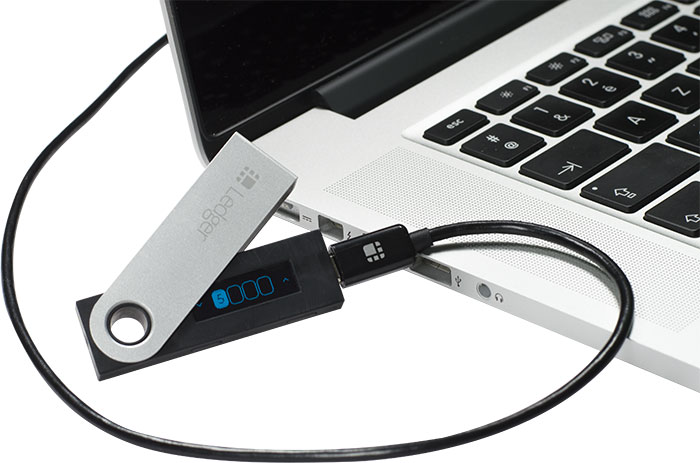It seems important to begin by clarifying that the word « Keychain » could be more appropriate than « portfolio » to the extent that the portfolios do not store any bitcoin, only public and private keys that allow the transfer. A portfolio is a software that will give you access to the bitcoin network and manage for you the purchase and sale operations . This software can be downloaded on your computer or used directly on the Internet. Obviously the security conditions will vary from one type of portfolio to another.
PRIVATE AND PUBLIC KEYS
If you compare the payment with bitcoins to the payment by credit card in a store, the public key corresponds to your credit card number, which identifies you and that you can transmit without too many risks, and the private key corresponds to your secret code, which allows you to validate the payment and that you must not disclose.
The term bitcoin portfolio refers both to the folder that contains your private key, but also the programs that generate public keys in order to create transactions, a little like your banker assigns you a credit card number and a secret code.
As you can imagine, the purpose of the portfolio is to retain bitcoins or Satoshi (1 satoahi = 0.00000001 bitcoins) but also to allow their expenditure. To do this, the portfolio enable its owner to distribute the public keys (to receive the bitcoins) and a program of signature of transactions with the help of private keys (for spending the bitcoins). To better understand a bitcoin transaction process you can read our article « 4 simple steps to understand a bitcoin transaction« .
The Portfolio must then be able to communicate such information to the bitcoin network and has therefore a third program in relationship with the network. The first two programs are not necessarily directly related to the last one. In other words, it is possible to generate public keys and sign transactions indirectly, without being connected to the bitcoin network, and to transmit them in a second time. There are many combinations of these transactions.
BITCOIN PORTFOLIO ON THE INTERNET (« HOT STORAGE »)
The most common portfolio types are online portfolios. These applications are based on the Internet and can be downloaded on your smartphone and computer. they are great for small payments of everyday life by using QR codes for instance. The QR code is just a way to encode your public key so that you can scan it from your smartphone. If you do not know what to do with your bitcoins do not hesitate to use my QR code to get rid of them:

Smartphones are considered less secure than the Portfolios located on a laptop, it is therefore recommended not to keep all your bitcoins on your mobile portfolio, but rather in a software downloaded locally on your computer and even better in « Cold storage » (see below).
With this type of portfolio, your private and public keys are stored on the website of a service provider. In other words, the three programs that we mentioned above are concentrated on a same platform in the hands of the same person. In other word you generally do not control your private keys, which is a risk because it means that you need to trust the company that manages the portfolio. The main advantage however is that you can access your portfolio from anywhere in the world.
PORTFOLIO DOWNLOADED LOCALLY
A more secure way to keep your cryptocurrencies is to download a portfolio directly on your computer. You therefore become master of your private key and you are much better protected against attacks, provided of course that your computer does not contain any virus such as spyware programed to collect your keys.
The ideal solution remains to save your private key out of the Internet on a USB keys secure, also called « physical portfolios » (or « Cold Storage »).
Ledger is a French start-up which proposes a portfolio that you can download on your computer or smartphone, but whose data are stored on a key that you insert into the USB port of your computer. All information relating to your bitcoins are therefore not in contact with the Internet. The models proposed by ledger now allow you to store not only your bitcoins, but also the main altcoins: Ether, XRP, dash, litecoin, Dogecoin, Zcash.

Other brands such as KeepKey or Trezor wallets are also very effective.
It is possible if not recommended to use both types of storage for your bitcoins, a little as you would do with your current account and your savings account. You can indeed keep only the bitcoins/Satoshi you need on your hot storage (portfolio online) and regularly transfer the surplus on your cold storage.
Another way not to expose its private key to the Internet and use a portfolio HD.
HIERARCHICAL DETERMINISTIC WALLET (or « HD wallet »)
Despite its barbaric qualifier, the hierarchical portfolio is today the most effective way to protect your bitcoins (with portfolios in cold storage). It is a little technical can, but concretely, a HD portfolio contains an initial Seed from which it will be possible to create many keys drifting all from each other and organized in trees in the following way:

This process has the huge advantage of being able to create an almost unlimited number of keys starting only of the initial seed, so it is much more secure since it is now sufficient to retain the initial seed in security (in cold storage for example) to be able to recreate, transfer or import the whole portfolio.
OUR ADVICES
- Encrypt your portfolio: it is important to use a password strong enough. Choose a good password is a necessary solution, but not sufficient, which should be combined with other means of protection such as those proposed below.
- Use all the means of protections proposed by the Portfolio: today almost all portfolios available offer an option of double authentication. It is in fact a additional protection that is to send on your mobile phone a message including a code that you must include on the home page of the portfolio to be able to access it.
- Keep the control of your private key: it is important not to entrust to a portfolio the care to manage your private key because it returns àleur entrust the safety of your bitcoins. It is therefore recommended to use only of portfolios with which you will keep the hand on your private key and keep a major part in « Cold Storage ».
- Do not reuse the same addresses: For reasons of security, it is advised to use a new address for each new transactions. Many are the portfolios which today allows to create an address by transaction (portefeuilleHD)
You can compare the different portfolios available on the market in the below chart:
[googlepdf url= »https://www.blockchains-expert.com/wp-content/uploads/2017/12/Wallets-comparison-Charts-2018.pdf » width= »100% » height= »1000″]
IF YOU ENJOYED THIS ARTICLE FEEL FREE TO SHARE IT OR ASK ANY QUESTIONS/COMMENTS BELOW!!





Hey buddy,
Someone have to tell you this: The time and work you put into these pages is insane.
I really like your page and i beg and hope you keep it going 😉
I did put that on my facebook
Thanks for your support and for sharing it!! Glad you enjoy it!